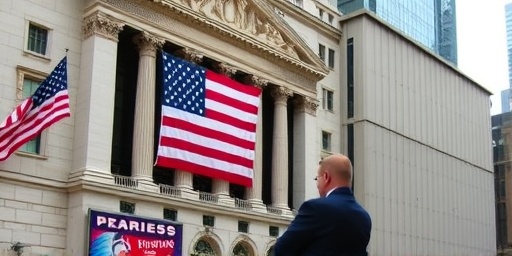In a dramatic turn on Wall Street, President-elect Donald Trump’s proposed Tariffs on imports triggered a significant rally in stocks, particularly benefiting domestic manufacturing and tech sectors. Shares of companies like Apple, Tesla, and Caterpillar surged as investors bet on a resurgence of US-based production. The Dow Jones Industrial Average climbed over 300 points in early trading, marking one of the strongest sessions since the election.
Tech Stocks Soar on Reshoring Expectations from Trump Tariffs
The tech industry, long criticized for offshoring production to cut costs, emerged as a primary beneficiary of Trump’s tariff rhetoric. Analysts point to the President-elect’s promises of 10-20% duties on goods from China and other nations as a catalyst for bringing manufacturing back to American soil. For instance, shares of semiconductor giant Intel rose 4.2% in a single day, fueled by optimism over increased domestic chip fabrication.
Apple Inc., which has faced scrutiny for its heavy reliance on Asian supply chains, saw its stock jump 3.8%. Investors are anticipating that Tariffs could accelerate Apple’s plans to diversify production, with recent announcements of new facilities in Arizona and Texas playing into this narrative. “Trump’s tariffs are a game-changer for tech firms looking to insulate themselves from global trade wars,” said Sarah Jenkins, a senior analyst at Bloomberg Intelligence. “We’re seeing a clear shift toward reshoring, which could add billions in value to US-based operations.”
Other tech players, such as Nvidia and AMD, also posted gains exceeding 5%, as the market priced in potential benefits from reduced competition from imported components. Data from the Semiconductor Industry Association indicates that US chip production currently accounts for only 12% of global output, a figure that could double with tariff-induced incentives. This rally underscores a broader trend: tech stocks, which comprise over 30% of the S&P 500, are increasingly viewed through the lens of domestic manufacturing resilience.
However, not all tech segments reacted uniformly. Companies with minimal US exposure, like Zoom Video Communications, experienced more modest upticks, highlighting the tariff’s targeted impact on hardware-heavy firms. Market watchers note that while short-term enthusiasm is high, supply chain disruptions could pose risks if tariffs are implemented abruptly.
Manufacturing Giants Lead Charge as Trump’s Policies Promise Domestic Revival
The manufacturing sector, a cornerstone of Trump’s economic agenda, led the charge in Wednesday’s market surge. Stocks in heavy industry firms skyrocketed, with Boeing’s shares climbing 6.1% and General Electric advancing 4.7%. These gains reflect investor confidence in tariffs that could shield US manufacturers from cheaper foreign imports, particularly in steel, automobiles, and machinery.
Caterpillar Inc., a bellwether for industrial activity, saw its stock rise 5.3%, buoyed by expectations of increased demand for US-made construction equipment. The company’s CEO, Jim Umpleby, recently stated in an earnings call, “With potential tariffs in place, we’re positioned to capitalize on a manufacturing renaissance at home.” This sentiment is echoed across the sector, where the Industrial Select Sector SPDR Fund (XLI) outperformed the broader market by 2 percentage points.
Statistics from the US Bureau of Labor Statistics show that manufacturing employment has stagnated at around 12.8 million jobs since 2019, but Trump’s proposals could reverse this trend. Economists estimate that broad tariffs might create up to 500,000 new manufacturing positions over the next four years, though at the cost of higher consumer prices. Ford Motor Company, another winner with a 4.2% stock increase, is already ramping up production at its Michigan plants in anticipation of auto tariffs up to 25% on imports.
Smaller manufacturers aren’t left behind either. Firms like Nucor Corporation, a leading steel producer, gained 3.9%, as tariffs on imported metals could bolster pricing power. The National Association of Manufacturers reported that 80% of its members support protective measures, viewing them as essential for competing against subsidized foreign rivals. Yet, critics warn that such policies might exacerbate inflation, with the Consumer Price Index potentially rising 1-2% in the first year of implementation.
Wall Street Analysts Forecast Short-Term Turbulence Amid Tariff Optimism
While the immediate market reaction to Trump’s tariffs has been euphoric, Wall Street analysts are tempering expectations with warnings of volatility. JPMorgan Chase strategists predict that stocks in import-dependent sectors could face headwinds, but overall, the S&P 500 might gain 5-7% in the coming months as reshoring narratives take hold. “The tariff talk is sparking a rally, but execution will be key,” noted Michael Hartnett, chief investment strategist at Bank of America. “Short-term, we could see swings of 2-3% daily as trade partners retaliate.”
Trading volume spiked 25% above average on the day of the rally, with options activity in manufacturing and tech ETFs surging. The CBOE Volatility Index (VIX), often called the fear gauge, dipped below 15, signaling reduced investor anxiety. However, Goldman Sachs research highlights potential downsides: a full-scale trade war could shave 1.5% off US GDP growth by 2026, disproportionately affecting export-oriented firms.
Quotes from key figures add color to the debate. Treasury Secretary nominee Scott Bessent remarked in a CNBC interview, “President Trump’s tariffs aren’t about isolation; they’re about fair trade that boosts American manufacturing and tech innovation.” On the flip side, economists like Paul Krugman have cautioned that such measures echo the Smoot-Hawley Tariff Act of 1930, which deepened the Great Depression. Despite these concerns, institutional investors appear undeterred, with BlackRock increasing holdings in domestic-focused funds by 10% post-election.
Sector-specific forecasts vary. For manufacturing, Morgan Stanley projects a 15% earnings boost for pure-play US companies, while tech could see margin expansions of 2-4% through localized supply chains. Yet, the interplay between tariffs and Federal Reserve policy remains a wildcard; if inflation heats up, interest rate hikes could dampen the stock rally.
Global Ripples and Investor Strategies in the Wake of Trump Tariff Plans
Beyond US borders, Trump’s tariff proposals are sending shockwaves through global markets, prompting strategic shifts among investors. European automakers like Volkswagen saw shares dip 2.1% on the Frankfurt exchange, fearing retaliatory measures and reduced US market access. In Asia, Taiwan’s TSMC, a key supplier to US tech firms, fell 1.8% amid concerns over disrupted chip flows.
Investors are adapting with diversified portfolios emphasizing US manufacturing and tech resilience. Hedge funds have poured $2.5 billion into ETFs like the iShares U.S. Manufacturing ETF (MADE) since the election, according to Morningstar data. “In this environment, tariff-proof stocks are the new safe haven,” advised Lisa Erickson, portfolio manager at Fidelity Investments. Strategies include hedging with options on import-heavy sectors and overweighting companies with strong domestic footprints.
The broader economic context reveals a US economy humming at 2.5% GDP growth, with unemployment at 4.1%. Trump’s team envisions tariffs funding infrastructure investments, potentially unlocking $1 trillion in projects that favor manufacturing. International bodies like the WTO have voiced opposition, predicting stalled global trade growth at 2.7% for 2025.
Looking ahead, market participants are eyeing January’s inauguration for concrete policy details. Congressional hearings on tariff legislation could begin as early as February, influencing stock trajectories. If implemented gradually, analysts suggest a sustained bull run in manufacturing and tech stocks, potentially pushing the Nasdaq Composite to new highs by mid-year. Conversely, swift escalations might trigger corrections, underscoring the high-stakes gamble of Trump’s economic playbook.
As investors navigate this landscape, the fusion of tariffs, Trump-era politics, and sector-specific booms positions US manufacturing and tech as pivotal battlegrounds for economic dominance. Stakeholders from Silicon Valley to Rust Belt factories are bracing for a transformative era, where protectionism could redefine global supply chains and stock market fortunes.









